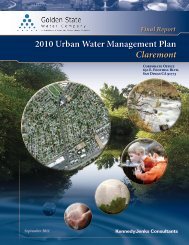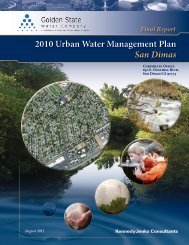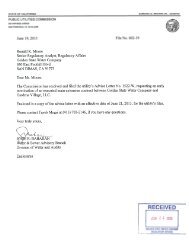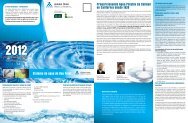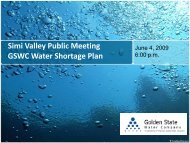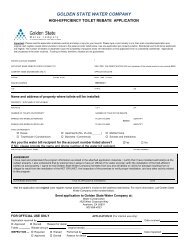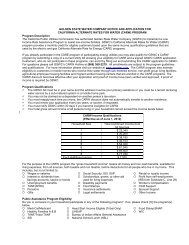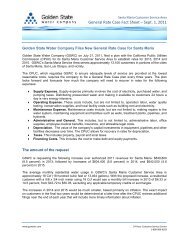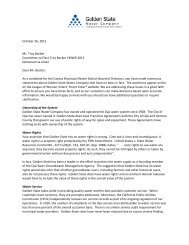(d)(e)(f)groundwater recharge, and other appropriate uses, and a determination with regard to the technical andeconomic feasibility of serving those uses.The projected use of recycled water within the supplier’s service area at the end of 5, 10, 15, and20 years, and a description of the actual use of recycled water in comparison to uses previously projectedpursuant to this subdivision.A description of actions, including financial incentives, which may be taken to encourage the use ofrecycled water, and the projected results of these actions in terms of acre feet of, recycled water used peryear.A plan for optimizing the use of recycled water in the supplier’s service area, including actions to facilitatethe installation of dual distribution systems, to promote recirculating uses, to facilitate the increased useof treated wastewater that meets recycled water standards, and to overcome any obstacles to achievingthat increased use.4.8.1 CoordinationTable 4-9 summarizes the role of the agencies that participated in the development of recycledwater plans that affect the <strong>Culver</strong> <strong>City</strong> System of the GSWC.Table 4-9:ParticipatingAgencies<strong>Water</strong> agenciesWastewater agenciesGroundwater agencies<strong>Plan</strong>ning agenciesRole of Participating Agencies in the Development of the Recycled <strong>Water</strong> <strong>Plan</strong>Role in <strong>Plan</strong> DevelopmentGSWC works closely with the West Basin Municipal <strong>Water</strong> District (WBMWD) inplanning a potential recycled water distribution system and identifying potentialrecycled water customers. WBMWD, acting as the recycled water wholesaler, wouldlead the way in implementing the recycled water plan and distribution network.WBMWD provides a reliable supply of recycled water that meets California recycledwater quality standards set forth in Title 22 of the California Code of Regulations.The <strong>Water</strong> Replenishment District of Southern California purchases recycled waterfrom WBMWD for injection into the West Coast Basin seawater barrierLos Angeles County Sanitation District, in conjunction with WBMWD, plays a key rolein conducting data and customer assessments, as well as analyzing community andeconomic impacts.4.8.2 Wastewater Quantity, Quality, and Current UsesWastewater in the <strong>Culver</strong> <strong>City</strong> System is collected by gravity sewers and lift stations owned bythe <strong>City</strong> of <strong>Culver</strong> <strong>City</strong>. The wastewater is transported through trunk sewers to the <strong>City</strong> of LosAngeles Bureau of Sanitation’s Hyperion Wastewater Treatment <strong>Plan</strong>t (WWTP) for treatment.The <strong>City</strong> of Los Angeles owns and operates the Hyperion WWTP. The Hyperion Treatment<strong>Plan</strong>t is a secondary treatment facility with a design capacity of 450 million gallons per day(mgd). The WWTP treats an average dry weather flow (DWF) of 300 mgd of wastewater,serving approximately 4 million people. Treatment at the Hyperion WWTP consists of screening,grit removal, and primary sedimentation with coagulation and flocculation. In secondarytreatment, the primary effluent is biologically treated in a high purity oxygen activated sludgeprocess. After clarification, The WBMWD purchases approximately 37,600 ac-ft/yr (roughly9 percent of Hyperion’s secondary effluent) for advanced treatment at the Edward C. Little<strong>Water</strong> Recycling Facility (ECLWRF) (WBMWD <strong>2010</strong> Draft UWMP). The remaining un-Page 4-8<strong>Final</strong> <strong>Report</strong>, <strong>2010</strong> <strong>Urban</strong> <strong>Water</strong> <strong>Management</strong> <strong>Plan</strong> – <strong>Culver</strong> <strong>City</strong>Golden State <strong>Water</strong> Companyg:\adminasst\jobs\<strong>2010</strong>\1070001.00_gswc-uwmp\09-reports\9.09-reports\2011-08\grp3\gswc_culvercity_<strong>2010</strong>_uwmp-final.doc
disinfected, secondary effluent (roughly 91 percent of Hyperion’s flow) is discharged to thePacific Ocean through a 5-mile submerged outfall pipe in Santa Monica Bay.WBMWD operates the ECLWRF, located in El Segundo, California, and is contractually entitledto receive up to 70 mgd of secondary effluent from the Hyperion WWTP for advanced treatment,but on average receives about 34 mgd. ECLWRF provides tertiary treatment to the Hyperionsecondary effluent to produce high-purity recycled water that complies with the requirements ofTitle 22 of the California Code of Regulations. The recycled water produced by ECLWRF isused for beneficial uses such as landscape irrigation, industrial applications (including coolingwater and boiler feed water), and other purposes such as groundwater injections to controlseawater intrusion.Because the Hyperion WWTP treats wastewater for a larger population than exists in the <strong>Culver</strong><strong>City</strong> System, an estimated per capita wastewater generation factor was used to calculate thevolume of wastewater generated by the customers in the <strong>Culver</strong> <strong>City</strong> System. The wastewatergeneration factor is based on the total population served and the average wastewater treatmentrate for the Hyperion WWTP. The WWTP serves approximately 4 million residents and treats anaverage of 300 mgd, making the average per capita wastewater generation factor for theHyperion WWTP 75 gallons per day (gpd).This factor was used to estimate the existing andprojected volumes of wastewater collected and treated in the <strong>Culver</strong> <strong>City</strong> System as shown inTable 4-10. Since about 9 percent of Hyperion’s effluent will be treated by WBMWD to meetrecycled water standards, the same percentage was used to estimate the amount of wastewatergenerated in the <strong>Culver</strong> <strong>City</strong> System that will be treated to meet recycled water standards. Theremaining 91 percent is assumed to be discharged into the Pacific Ocean. Table 4-11 lists theestimates of existing and projected volumes of treated effluent that will be discharged into thePacific Ocean. Table 4-12 was intentionally left blank as there are no existing uses of recycledwater by the GSWC customers in the <strong>Culver</strong> <strong>City</strong> System.Table 4-10:Estimates of Existing and Projected Wastewater Collection and Treatment in ac-ft/yr (mgd)for the <strong>Culver</strong> <strong>City</strong> System2005 (2) <strong>2010</strong> (2) 2015 2020 2025 2030 2035Projectedpopulation in 36,413 36,704 36,872 37,091 37,299 37,495 37,679service area (1)Wastewatercollected &3,059treated in (2.73 mgd)service area (3)3,084(2.75 mgd)3,098(2.77 mgd)3,116(2.78 mgd)3,134(2.80 mgd)3,150(2.81 mgd)3,165(2.83 mgd)Quantity thatmeets recycledwater standard275(0.25 mgd)278(0.25 mgd)279(0.25 mgd)280(0.25 mgd)282(0.25 mgd)283(0.25 mgd)Notes:1. For population projections see Section 2.3.2. Based on actual year.3. Values of wastewater collected and treated are estimated. For a description of the methodology, refer to the text.4. This table is based on the DWR Guidebook Table 21.285(0.25 mgd)<strong>Final</strong> <strong>Report</strong>, <strong>2010</strong> <strong>Urban</strong> <strong>Water</strong> <strong>Management</strong> <strong>Plan</strong> – <strong>Culver</strong> <strong>City</strong> Page 4-9Golden State <strong>Water</strong> Companyg:\adminasst\jobs\<strong>2010</strong>\1070001.00_gswc-uwmp\09-reports\9.09-reports\2011-08\grp3\gswc_culvercity_<strong>2010</strong>_uwmp-final.doc
- Page 6 and 7:
Table of Contents (cont’d)Chapter
- Page 8:
Table of Contents (cont’d)List of
- Page 11 and 12:
Notice of AdoptionA meeting to soli
- Page 13 and 14:
Abbreviationsac-ftac-ft/yr or AFYAc
- Page 15 and 16: O&MRHNARTPoperation and maintenance
- Page 17 and 18: DefinitionsChapter 2, Part 2.6, Div
- Page 19 and 20: Chapter 1: Plan Preparation1.1 Back
- Page 21 and 22: ¯1%&'( 10%&'( 405MilesImage Source
- Page 23 and 24: 1.4 Public Utility Commission 2010
- Page 25 and 26: 1.6 Plan Adoption and SubmittalPubl
- Page 27 and 28: Table 1-2:Summary of UWMP Chapters
- Page 29 and 30: Chapter 2: System DescriptionChapte
- Page 31 and 32: %&'(10405%&'(Path: Z:\Projects\GSWC
- Page 33 and 34: 2.3 Population, Housing and Employm
- Page 35 and 36: %&'(10702400702501702502702801%&'(4
- Page 37 and 38: As concluded from analysis of SCAG
- Page 39 and 40: Table 2-3:Monthly Average Climate D
- Page 41 and 42: Chapter 3: Water UseSection 10631(e
- Page 43 and 44: System (NAICS) codes. Then, the sor
- Page 45 and 46: Table 3-2:Base Period RangesBase Pa
- Page 47 and 48: 3.2.2 Urban Water Use TargetsRetail
- Page 49 and 50: 3.3 Projected Water UseGrowth proje
- Page 51 and 52: The population-based water use proj
- Page 53 and 54: 3.4 Sales to Other AgenciesThere ar
- Page 55 and 56: Total Water Demand(ac-ft/yr)8,0007,
- Page 57 and 58: GSWC will not deny or conditionally
- Page 59 and 60: Chapter 4: Water SupplyA detailed e
- Page 61 and 62: 4.2 Imported WaterWBMWD is a large
- Page 63 and 64: Table 4-4:Future Water Supply Proje
- Page 65: The WBMWD is also involved in resea
- Page 69 and 70: Table 4-15:Comparison of Recycled W
- Page 71 and 72: Chapter 5: Water QualitySection 106
- Page 73 and 74: 5.2.3 Distribution System Water Qua
- Page 75 and 76: Chapter 6: Water Supply Reliability
- Page 77 and 78: • 1999 Water Surplus and Drought
- Page 79 and 80: 6.1.3 Factors Resulting in Inconsis
- Page 81 and 82: Table 6-7:Projected Multiple-Dry Ye
- Page 83 and 84: Chapter 7: Conservation Program and
- Page 85 and 86: Table 7-1:CUWCC BMP and UWMP DMMs O
- Page 87 and 88: • Use of potable water which resu
- Page 89 and 90: evenue consisted of 62.8 percent of
- Page 91 and 92: There are no direct estimates of wa
- Page 93 and 94: amount of water used to wash a stan
- Page 95 and 96: 7.4.1.6 Commercial, Industrial, and
- Page 97 and 98: However, if the gpcd begins to incr
- Page 99 and 100: Chapter 8: Water Shortage Contingen
- Page 101 and 102: Stage III (20 - 35 percent shortage
- Page 103 and 104: Possible CatastropheTable 8-3:Summa
- Page 105 and 106: In addition to prohibitions, Rule N
- Page 107 and 108: Table 8-10:Names of MeasuresObtain
- Page 109 and 110: Chapter 9: ReferencesCalifornia Dep
- Page 111: Appendix AUrban Water Management Pl
- Page 114 and 115: on water management strategies and
- Page 116 and 117:
supplier will be reviewing the plan
- Page 118 and 119:
(J) Wholesale agency programs.(K) C
- Page 120 and 121:
determine that an urban water suppl
- Page 122 and 123:
sequence for the agency's water sup
- Page 124 and 125:
WATER CODESECTION 10640-1064510640.
- Page 126 and 127:
WATER CODESECTION 10650-1065610650.
- Page 129:
Appendix BPublic Hearing Notices, N
- Page 132:
June 8, 2011City of Culver CitySol
- Page 136 and 137:
Culver City Community Service Area
- Page 139:
No Meeting Minutes were taken since
- Page 143 and 144:
4CUWCC BMP RETAIL COVERAGE REPORT 2
- Page 145 and 146:
Agency: Golden State Water Company
- Page 147 and 148:
4CUWCC BMP RETAIL COVERAGE REPORT 2
- Page 149 and 150:
California Urban Water Conservation
- Page 151 and 152:
CUWCC BMP COVERAGE REPORT BMP 3 RES
- Page 153:
Agency: Golden State Water Company
- Page 156 and 157:
Agency: Golden State Water Company
- Page 159 and 160:
SOUTHERN CALIFORNIA WATER COMPANY R
- Page 161 and 162:
SOUTHERN CALIFORNIA WATER COMPANY R
- Page 163 and 164:
SOUTHERN CALIFORNIA WATER COMPANY R
- Page 165 and 166:
SOUTHERN CALIFORNIA WATER COMPANY R
- Page 167 and 168:
SOUTHERN CALIFORNIA WATER COMPANY R
- Page 169 and 170:
SOUTHERN CALIFORNIA WATER COMPANY R
- Page 171 and 172:
GOLDEN STATE WATER COMPANY Revised
- Page 173 and 174:
GOLDEN STATE WATER COMPANY Revised
- Page 175 and 176:
GOLDEN STATE WATER COMPANY Original
- Page 177 and 178:
GOLDEN STATE WATER COMPANY Original
- Page 179 and 180:
GOLDEN STATE WATER COMPANY Original
- Page 181:
Appendix EDMM Supporting Documents
- Page 184 and 185:
GOLDEN STATE WATER COMPANY Revised
- Page 187:
Appendix F(Not Applicable; Appendix
- Page 191 and 192:
Urban Water Management PlanCulver C
- Page 193:
Appendix HDocumentation of submitta
- Page 196 and 197:
September 1, 2011City of Los Angele
- Page 198 and 199:
September 1, 2011County of Los Ange
- Page 203:
Appendix JUrban Water Management Pl
- Page 206 and 207:
No. UWMP requirement a Calif. Water
- Page 208 and 209:
No. UWMP requirement a Calif. Water
- Page 210 and 211:
No. UWMP requirement a Calif. Water
- Page 212:
UWMPlocationPageNumber7.2 7-4a The




